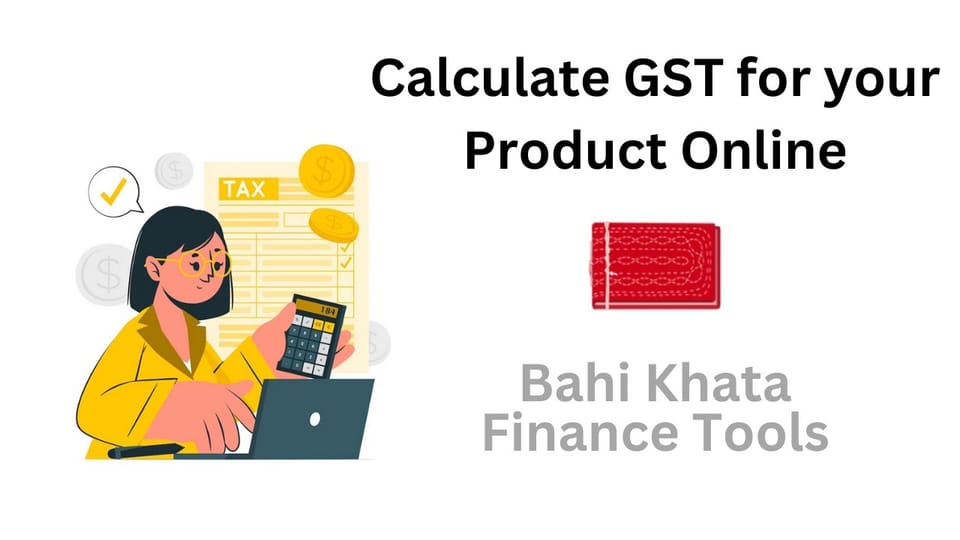GST Calculator Online: Calculate your Gst

Introduction About GST Calculator:
- A Goods and Services Tax (GST) calculator is a tool that helps individuals and businesses compute the GST they need to pay or collect on their transactions. GST is a consumption tax that is levied on the supply of goods and services at each stage of the supply chain, from the manufacturer to the consumer. The GST calculator simplifies the process of determining the GST amount by taking into account the applicable GST rate and the value of the goods or services involved.
Here are the key components and features of a GST calculator:
GST Rates:
- GST is categorized into different rates, such as 0%, 5%, 12%, 18%, and 28%, depending on the type of goods or services. The calculator considers the relevant GST rate for accurate calculations.
Type of Supply:
- The GST calculation may vary based on the type of supply, which could be an intra-state supply (within the same state) or an inter-state supply (across different states). Different GST rates may apply to these types of supplies.
Input and Output GST:
- The calculator helps determine both Input GST (IGST), which is the tax paid on purchases, and Output GST, which is the tax collected on sales. The net GST payable or receivable is then computed based on the input and output GST.
Value of Goods or Services:
- Users need to input the value of the goods or services for which they want to calculate the GST. This is the amount on which the GST will be applied.
Final GST Amount:
- The calculator provides the final GST amount to be paid or collected. It breaks down the amount into the central GST (CGST), state GST (SGST), and integrated GST (IGST) components based on the type of supply.
Reverse Charge Mechanism:
- In some cases, the liability to pay GST may be on the recipient of the goods or services instead of the supplier. The calculator may also account for such scenarios through the reverse charge mechanism.
Advantages of GST Calculator:
Accuracy in Calculations:
- GST calculations can become complex, especially in scenarios involving different tax rates, types of supplies, and inter-state transactions. A GST calculator ensures accurate calculations, minimizing the risk of errors that may occur when manually computing GST amounts.
Time Efficiency:
- The automated nature of GST calculators saves time compared to manual calculations. Businesses can quickly determine their GST liability or input tax credit, allowing for efficient financial management and decision-making.
Compliance with Regulations:
- GST calculators are designed to incorporate the latest tax rates and rules, ensuring that users stay compliant with the prevailing regulations. This helps businesses avoid penalties and legal issues associated with non-compliance.
Ease of Use:
- Most GST calculators are user-friendly and do not require extensive knowledge of tax laws. Users can input the necessary details, and the calculator performs the calculations, making it accessible to a wide range of individuals, including small businesses and entrepreneurs.
Real-time Updates:
- Some GST calculators are equipped with features that provide real-time updates on changes in tax rates or regulations. This ensures that users always have access to the most current information, helping them adapt to any modifications in the tax system promptly.
Financial Planning:
- Businesses can use GST calculators to project and plan for their tax liabilities, helping them manage cash flow effectively. By understanding their GST obligations, businesses can make informed decisions about pricing, expenses, and overall financial strategies.
Reduced Human Error:
- Automation reduces the likelihood of human errors in calculations. This is crucial for businesses dealing with large volumes of transactions, as errors in GST calculations can lead to financial discrepancies and compliance issues.
Reverse Charge Mechanism Handling:
- For businesses dealing with the reverse charge mechanism, a GST calculator can handle these scenarios accurately, ensuring that the correct party is identified as the taxpayer in such transactions.
Customization:
- Some GST calculators allow for customization based on specific business needs or industry requirements. This flexibility ensures that businesses can adapt the tool to suit their unique circumstances.
Record Keeping:
- Many GST calculators also offer features for maintaining records of transactions and calculations. This helps businesses keep track of their financial history and facilitates auditing processes.
What is GST(Goods And Service Tax)?
- Goods and Services Tax (GST) is a comprehensive indirect tax levied on the supply of goods and services at each stage of the production and distribution chain. It is a destination-based tax, which means it is ultimately borne by the end consumer. GST is designed to replace various indirect taxes that were previously levied by the central and state governments in India, as well as streamline the taxation system.
How many types of taxes will be in GST?
Tax Components Under GST:
Under the Goods and Services Tax (GST) system, there are three main tax components:
Central Goods and Services Tax (CGST):
- Definition: CGST is the tax levied by the Central Government on the intra-state supply of goods and services.
- Collection: The revenue collected through CGST goes to the Central Government.
- Applicability: It is applicable when both the supplier and the recipient are located within the same state.
State Goods and Services Tax (SGST):
- Definition: SGST is the tax levied by the State Government on the intra-state supply of goods and services.
- Collection: The revenue collected through SGST goes to the respective State Government.
- Applicability: It is applicable when both the supplier and the recipient are located within the same state.
Integrated Goods and Services Tax (IGST):
- Definition: IGST is the tax levied by the Central Government on the inter-state supply of goods and services.
- Collection: The revenue collected through IGST goes to the Central Government.
- Applicability: It is applicable when the supply involves movement of goods or services from one state to another or from one country to another.
What are the 5 types of GST rate?
- The primary GST slabs for any regular taxpayers are presently pegged at 0% , 5%, 12%, 18% & 28%.
How is GST calculated with example?
- The calculation of Goods and Services Tax (GST) involves applying the appropriate GST rate to the value of the goods or services being supplied. The GST calculation can vary depending on the type of supply (intra-state or inter-state) and the specific GST rates applicable to the goods or services. Here are the general steps for calculating GST:
Determine the Type of Supply:
- Intra-state Supply: If the supply of goods or services is within the same state, both Central Goods and Services Tax (CGST) and State Goods and Services Tax (SGST) are applicable.
- Inter-state Supply: If the supply involves movement of goods or services from one state to another or from one country to another, Integrated Goods and Services Tax (IGST) is applicable.
Identify the GST Rates:
- GST rates are specified for various categories of goods and services. The rates include 0%, 5%, 12%, 18%, and 28%, depending on the nature of the goods or services.
Calculate GST Amount:
For Intra-state Supply:
- CGST = (Supply Value * CGST Rate) / 100
- SGST = (Supply Value * SGST Rate) / 100
- Total GST = CGST + SGST
For Inter-state Supply:
- IGST = (Supply Value * IGST Rate) / 100
Determine the Total Invoice Value:
- Total Invoice Value = Supply Value + Total GST
Here's a simple example for an intra-state supply with CGST and SGST:
Suppose the supply value of goods or services is Rs. 1,000 and the CGST and SGST rates are both 5%.
- CGST = (1,000 * 5%) = Rs. 50
- SGST = (1,000 * 5%) = Rs. 50
- Total GST = CGST + SGST = Rs. 50 + Rs. 50 = Rs. 100
- Total Invoice Value = Supply Value + Total GST = Rs. 1,000 + Rs. 100 = Rs. 1,100
For an inter-state supply, you would use the IGST rate instead.
Please follow us on our social site and YouTube and subscribe to our website.
Manage your business cash flows and payable/receivables using our Bahi Khata App.




Comments ()